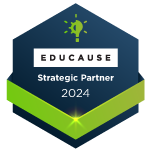Discover how the University of Health Science and Pharmacy seamlessly migrated from Moodle to Brightspace, overcoming complex LMS migration challenges with expert support from K16 Solutions.
The University of Health Sciences and Pharmacy (UHSP), formerly known as the St. Louis College of Pharmacy, has a distinguished legacy dating back to 1864. As one of the oldest and most respected pharmacy schools in the United States, UHSP is a leading institution dedicated to advancing education in the health sciences. In addition to the historic College of Pharmacy, UHSP houses the College of Arts and Sciences, the College of Global Population Health, and the College of Graduate Studies, all of which contribute to its diverse academic offerings.

However, like many universities, UHSP faced a significant challenge: Its learning management system (LMS) was aging, and the time had come for an upgrade.
Making the Decision to Move LMS Platforms
UHSP had relied on Moodle as its LMS platform for over a decade. Moodle served its purpose well, providing a flexible and customizable environment for faculty and students. However, the contract between UHSP and Moodle was ending, and many of the key features of the LMS were no longer supported. Additionally, advances in LMS technology meant that newer platforms could better meet the evolving needs of the institution.

The university embarked on a comprehensive evaluation of LMS alternatives, considering factors like ease of use, functionality, and the ability to support faculty and students more effectively. After nearly a year of evaluations, focus groups consisting of faculty, staff, and students unanimously chose Brightspace as the ideal replacement for Moodle.
But selecting a new platform was only the beginning. UHSP then faced the daunting task of migrating years of complex course content, some of which was not compatible with the new system. For the instructional design team, this posed a major hurdle. How could they ensure the transition would be smooth and that faculty, in particular, would adopt the new system without feeling overwhelmed?
Addressing the Challenges of LMS Migration
Migrating from one LMS to another is no small feat, especially for a university like UHSP that has accumulated a wealth of content over the years. The migration process involved transferring content that often didn't align one-to-one between the old and new systems. Foundational elements such as course displays, names, and structures varied, making it difficult to preserve the familiarity faculty relied on.
Faculty adoption was another major concern. Many faculty members had grown accustomed to Moodle's specific features and workflows. The prospect of learning an entirely new system—especially one with different navigation and functionalities—was daunting. The UHSP instructional design team knew that faculty buy-in would be crucial for a successful transition.
Lastly, the team is small. With limited capacity to manually migrate courses and provide faculty training, UHSP needed external support to make the migration a success.
Finding a Migration Partner to Ease the Transition
Understanding the magnitude of the task, UHSP sought out a partner that could help facilitate the migration process. During its evaluation of Brightspace, UHSP discovered K16 Solutions, a company specializing in LMS migrations, archiving, and data management. K16's Scaffold Migration service stood out as the perfect solution for UHSP's needs.
Scaffold Migration is designed to streamline LMS migrations, making the process faster, easier, and more efficient. By automating much of the work that traditionally requires manual intervention, K16 enables institutions to move content from one LMS to another without the need for extensive internal resources. For UHSP, this was a game changer.
Jeanene Singleton, the director of academic technology at UHSP, recalled how K16's expertise gave the team confidence to proceed with the migration. "We would have been more hesitant to migrate without K16," she said. "Scaffold Migration increased our confidence to proceed by providing us a safety net."
The Migration Process: Overcoming Key Challenges
One of the first steps in UHSP's migration was transferring the most challenging courses—those that contained unique functions, data structures, and complex content that did not easily translate between systems. K16 worked closely with the instructional design team at UHSP, demoing courses and providing the opportunity to give feedback and perfect the migration before rolling out the new platform to faculty.
Emily Fetick, lead instructional designer at UHSP, praised the level of detail K16 brought to the task. "The willingness to sit down, answer our questions, and walk us through what they were doing made the difference for us. The K16 team consistently kept us informed about the progress. The personalized attention we received was incredibly important to us."
The migration was not only about moving content; it was also about helping faculty feel confident in the new system. UHSP was keenly aware that faculty buy-in would make or break the success of the transition. By relying on K16 to handle the technical aspects of the migration, UHSP was able to focus on preparing faculty for the change.
While K16 migrated the courses, the university's small instructional design team focused on developing a training plan for faculty. This plan included asynchronous courses, synchronous training sessions, one-on-one support, and open office hours—all designed to ease the transition to Brightspace.Footnote1 By the time the migration was complete, faculty had received extensive training and were ready to navigate the new system with confidence.
How Scaffold Migration Works
Scaffold Migration takes the pain out of LMS migrations. Using a fully automated process, Scaffold Migration transfers courses, quizzes, assignments, and other content from one LMS to another, ensuring that everything remains intact and organized in the new system.Footnote2
One of the key advantages of Scaffold Migration is its ability to handle complex data and unique course content that may not have a direct equivalent in the new LMS. For example, UHSP faculty were concerned about how custom reports and quiz questions with specific learning outcomes would transfer to the new learning outcomes feature in Brightspace. K16 was able to migrate this content seamlessly, eliminating the need for faculty to manually rebuild reports—a process that would have been time-consuming and frustrating.
Additionally, Scaffold Migration ensures that all courses are thoroughly tested before the migration is finalized, allowing institutions to provide feedback and make adjustments as needed. This level of customization and attention to detail sets K16 apart from other migration services.
By automating the migration process, K16 saves institutions significant time and resources.Footnote3 In UHSP's case, the small instructional design team simply didn't have the capacity to manually migrate all of the courses and still provide faculty training. K16's support allowed them to focus on training faculty, ensuring a smooth and successful transition to Brightspace.
Result: A Smooth, Seamless Transition
Once the migration was complete, UHSP provided faculty access to their new courses and a comprehensive course readiness guide. The migration had gone smoothly, with no major issues or disruptions. Faculty who had been concerned about the transition initially expressed relief and satisfaction with the process.
For UHSP, one of the biggest wins was the time the institution saved during the migration. K16's ability to handle complex data transfers, such as quiz questions with associated outcomes, eliminated hours of manual work that faculty would have had to complete otherwise. Scaffold Migration made the migration process more efficient and helped secure faculty support for the transition.
UHSP was also impressed by the level of customer support they received from K16. "We're extremely grateful for the dedication and hard work of Kurumbidza Chani, client success manager at K16, and his team. Their expertise and customer-focused approach provided us with a positive migration experience," said Singleton.
The successful migration has enabled UHSP to continue delivering an exceptional learning experience to students on a modern, fully supported LMS platform.
Conclusion: The K16 Advantage for Higher Education
For universities like UHSP, transitioning to a new LMS can be complex and overwhelming. However, with the right partner, it doesn't have to be. Scaffold Migration by K16 Solutions offers a streamlined, automated solution that simplifies the migration process and ensures that institutions can focus on what matters most—supporting faculty and enhancing the student learning experience.
If your institution is about to migrate to a new LMS or is already in the process and needs extra support, talk with a migration expert at K16 Solutions to make the transition easy.
 EDUCAUSE Strategic Partners
EDUCAUSE Strategic Partners
EDUCAUSE Strategic Partners work closely with EDUCAUSE staff and community members on key areas of higher education and technology to help strengthen collaboration and evolve the higher ed technology market. Learn more about K16 Solutions, a 2024 EDUCAUSE Strategic Partner, and how they're partnering with EDUCAUSE to support your evolving technology needs.
Notes
- Rae Shaffer, "Your Step-by-Step Guide for Successful LMS Course Migration," K16 Blog, August 25, 2022. Jump back to footnote 1 in the text.
- Rae Shaffer, "What Is Automated LMS Migration?" K16 Blog, June 12, 2022. Jump back to footnote 2 in the text.
- Rae Shaffer, "How Long Does an LMS Migration Project Really Take?" K16 Blog, August 8, 2022. Jump back to footnote 3 in the text.
© 2024 K16 Solutions.
